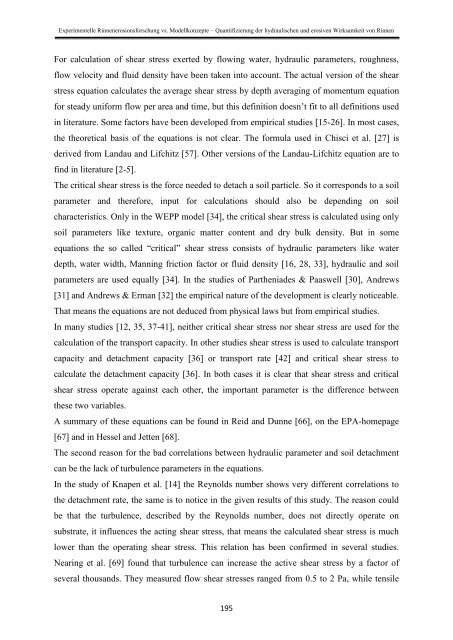Stefan Wirtz Vom Fachbereich VI (Geographie/Geowissenschaften ...
Stefan Wirtz Vom Fachbereich VI (Geographie/Geowissenschaften ...
Stefan Wirtz Vom Fachbereich VI (Geographie/Geowissenschaften ...
You also want an ePaper? Increase the reach of your titles
YUMPU automatically turns print PDFs into web optimized ePapers that Google loves.
Experimentelle Rinnenerosionsforschung vs. Modellkonzepte – Quantifizierung der hydraulischen und erosiven Wirksamkeit von Rinnen<br />
For calculation of shear stress exerted by flowing water, hydraulic parameters, roughness,<br />
flow velocity and fluid density have been taken into account. The actual version of the shear<br />
stress equation calculates the average shear stress by depth averaging of momentum equation<br />
for steady uniform flow per area and time, but this definition doesn’t fit to all definitions used<br />
in literature. Some factors have been developed from empirical studies [15-26]. In most cases,<br />
the theoretical basis of the equations is not clear. The formula used in Chisci et al. [27] is<br />
derived from Landau and Lifchitz [57]. Other versions of the Landau-Lifchitz equation are to<br />
find in literature [2-5].<br />
The critical shear stress is the force needed to detach a soil particle. So it corresponds to a soil<br />
parameter and therefore, input for calculations should also be depending on soil<br />
characteristics. Only in the WEPP model [34], the critical shear stress is calculated using only<br />
soil parameters like texture, organic matter content and dry bulk density. But in some<br />
equations the so called “critical” shear stress consists of hydraulic parameters like water<br />
depth, water width, Manning friction factor or fluid density [16, 28, 33], hydraulic and soil<br />
parameters are used equally [34]. In the studies of Partheniades & Paaswell [30], Andrews<br />
[31] and Andrews & Erman [32] the empirical nature of the development is clearly noticeable.<br />
That means the equations are not deduced from physical laws but from empirical studies.<br />
In many studies [12, 35, 37-41], neither critical shear stress nor shear stress are used for the<br />
calculation of the transport capacity. In other studies shear stress is used to calculate transport<br />
capacity and detachment capacity [36] or transport rate [42] and critical shear stress to<br />
calculate the detachment capacity [36]. In both cases it is clear that shear stress and critical<br />
shear stress operate against each other, the important parameter is the difference between<br />
these two variables.<br />
A summary of these equations can be found in Reid and Dunne [66], on the EPA-homepage<br />
[67] and in Hessel and Jetten [68].<br />
The second reason for the bad correlations between hydraulic parameter and soil detachment<br />
can be the lack of turbulence parameters in the equations.<br />
In the study of Knapen et al. [14] the Reynolds number shows very different correlations to<br />
the detachment rate, the same is to notice in the given results of this study. The reason could<br />
be that the turbulence, described by the Reynolds number, does not directly operate on<br />
substrate, it influences the acting shear stress, that means the calculated shear stress is much<br />
lower than the operating shear stress. This relation has been confirmed in several studies.<br />
Nearing et al. [69] found that turbulence can increase the active shear stress by a factor of<br />
several thousands. They measured flow shear stresses ranged from 0.5 to 2 Pa, while tensile<br />
195
















